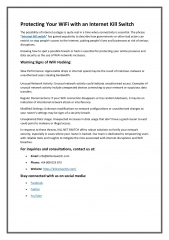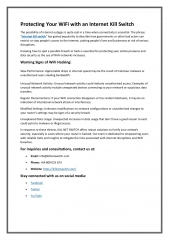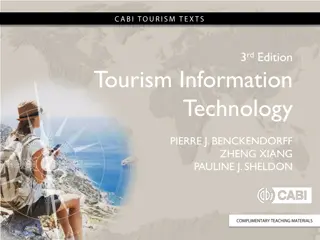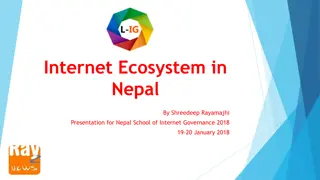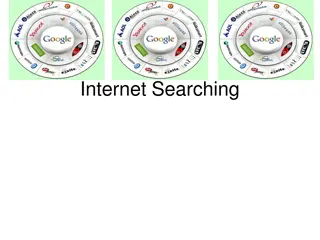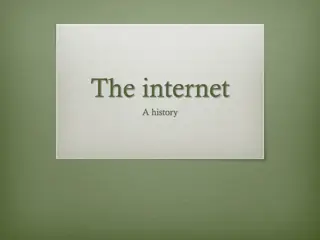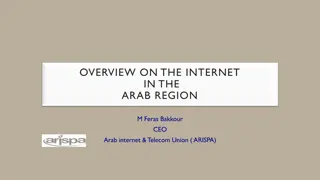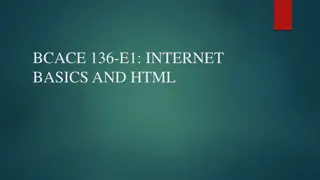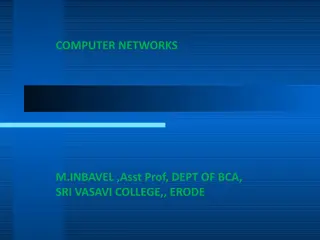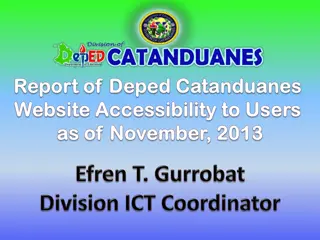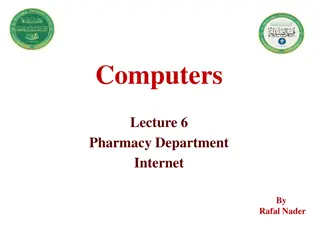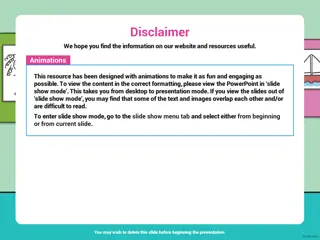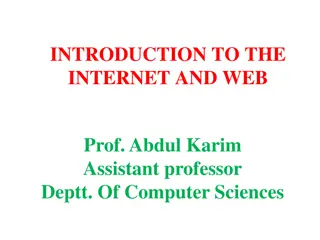Understanding the Basics of the Internet
The internet is a vast network of interconnected computer networks worldwide that use the standard Internet protocol. It has evolved through history from the development of electronic computers in the 1950s to its current state where various entities own different parts of the infrastructure. Different types of internet connections exist, such as Dial-Up, DSL, Cable, Wireless, Satellite, and Cellular. Understanding the ownership, history, and connections of the internet provides key insights into this global system.
- Internet Basics
- Internet History
- Internet Connections
- Ownership of the Internet
- Networking Technologies
Download Presentation

Please find below an Image/Link to download the presentation.
The content on the website is provided AS IS for your information and personal use only. It may not be sold, licensed, or shared on other websites without obtaining consent from the author. Download presentation by click this link. If you encounter any issues during the download, it is possible that the publisher has removed the file from their server.
E N D
Presentation Transcript
Introduction To Internet Chapter One
What is the internet Internet interconnected computer networks that use the standard Internet protocol (often called TCP/IP) to serve billions of users worldwide. It is a network of networks that consists of millions of private, public, academic, business, networks, of local to global scope, that are linked by networking technologies. is a global system of and government
History of the internet the history of the Internet begins with the development of electronic computers in the 1950s. The US Department contracts as early as the 1960s, including for the development of the ARPANET project. The first message was sent over the ARPANET in 1969 from computer at University of California, Los Angeles to the second network at Institute (SRI). of Defense awarded science laboratory Stanford Research
Who Owns the Internet? There are many organizations, corporations, governments, schools, private citizens and service providers that all own pieces of the infrastructure, but there is no one body that owns it all. There are, however, organizations that oversee and standardize what happens on the Internet and assign IP addresses and domain names, such as the National Science Foundation, the Internet Engineering Task Force, ICANN , InterNICand the Internet Architecture Board.
Internet Connections There are many ways a personal electronic device can connect to the internet. They all use different hardware and each has a range of connection speeds: 1. Dial-Up (Analog 56K). 2. DSL 3. Cable 4. Wireless 5. Satellite 6. Cellular
1.Dial-Up Dial-up access is cheap but slow. A modem connects to the Internet after the computer dials a phone number. This analog signal is converted to digital via the modem and sent over a land-line serviced by a public telephone network. Telephone lines are variable in quality and the connection can be poor at times. The lines regularly experience interference and this affects the speed. Since a computer or other device shares the same line as the telephone, they can t be active at the same time. Speed: 28K to 56K
2. DSL DSL stands for Digital Subscriber Line. It is an internet connection that is always on . uses 2 lines so your phone is not tied up when your computer is connected. There is also no need to dial a phone number to connect. DSL uses a router to transport data. Speed: 128K to 8 Mbps
3. Cable Cable provides an internet connection through a cable modem and operates over cable TV lines. There are different speeds depending on if you are uploading data downloading. The coax cable provides a much greater bandwidth over dial-up or DSL telephone lines. Speed: 512K to 20 Mbp. transmissions or
4. Wireless Wireless, or Wi-Fi, does not use telephone lines or cables to connect to the internet. It uses radio frequency. Wireless is also an always on connection and it can be accessed from just about anywhere. Speed: 5 Mbps to 20 Mbps.
5. Satellite Satellite accesses the internet via a satellite in Earth s orbit. The enormous distance that a signal travels from earth to satellite and back again, provides connection compared to cable and DSL. Speed: 12K to 2.0 Mbps a delayed
6. Cellular Cellular. Internet access through cell phones. The speeds vary depending on the provider, but the most common are 3G and 4G speeds. A 3G is a term that describes a 3rdgeneration cellular network obtaining mobile speeds Mbps. 4G is the fourth generation of cellular wireless standards. The goal of 4G is to achieve peak mobile speeds of 100 Mbps but the reality is about 21 Mbps currently. Cellular technology provides wireless of around 2.0
Advantages of the Internet you can send and receive e-mails you can get in touch with your friends you can do shopping you can downloads files, music and films you can find interesting materials you can meet/get to know a lot of people you can find flat or jobs quickly the net is easy and fast source of information the net makes our work easier the net enables us to do shopping, pay bills without leaving our homes the net saves our time (we don t have to stay in queue) provides entertainment And much more ..
Disadvantages of the Internet Although the Internet is one of the greatest creations, it also has many disadvantages. Because the internet is easily accessible to anyone, it can be a dangerous place. You have to know who you're dealing with or what you're getting into. Predators, cyber criminals, bullies, and corrupt businesses will try to take advantage of the unwary visitor.
Disadvantages of the Internet Bullying, trolls, stalkers, and crime Exploitation and pornography and violent images Addiction, time waster, and causes distractions Never being able to disconnect Identity theft, hacking, viruses, and cheating Spam and advertising Depression, loneliness, and social isolation Health issues and obesity Buying things not needed https://www.computerhope.com/issues/ch001810.htm
Electronic Communication Theory This theory emphasized the technical problems of transm itting a message from a sender to a receiver. It is based on, and uses the language of, electronics. The message begins with an information source, the mind of the sender (writer or speaker), who encodes a message into words and sentences. The message is transmitted as signal (text on paper or so und waves) through a channel, where it may be distorted by noise (such as smudged typing or acoustical problems) . The receiver (listener or reader) decodes the message
Communication Model Noise


